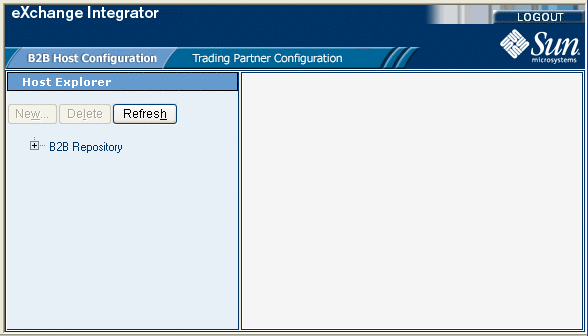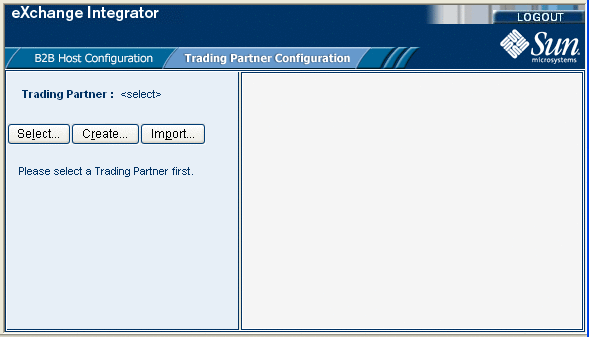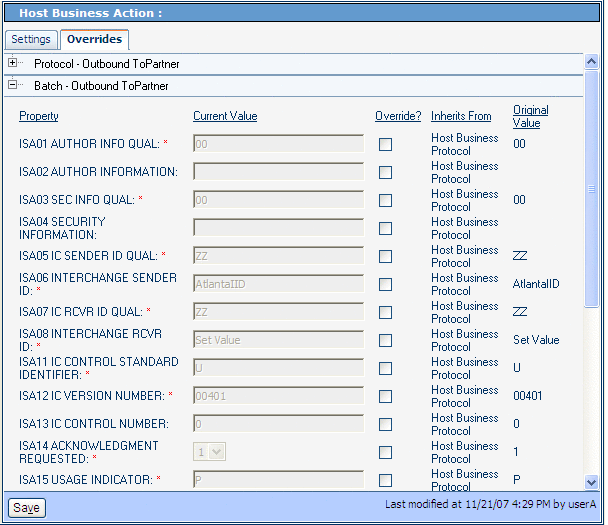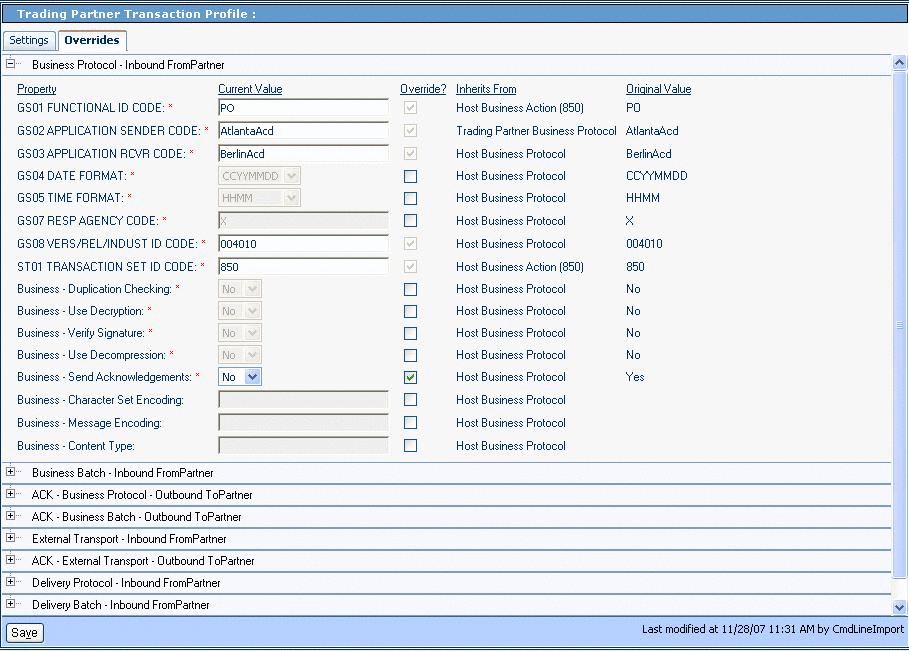Importing and Configuring Components in ePM
This section explains how import, create, and configure TPs, Action Groups, Transaction Profiles, and Schedules in the ASC X12 PM sample scenario, using the eXchange ePM. Additionally, the section describes how to use ePM to set the configuration parameter values for the Transaction Profiles and their related components.
Note –
For detailed procedures on how to use TPs, Action Groups, Transaction Profiles, and Schedules, see the eXchange Integrator User’s Guide.
Getting Started
Before you begin, it is recommended that you do all the procedures given in the previous sections of this chapter. Also, your Integration Server must be running. Also, your LDAP system and eXchange database (Oracle) must be running and accessible. However, Enterprise Designer does not need to be running.
Note –
For a general description of the outbound and inbound messaging ToPartner and FromPartner model used by ePM, see Configuring ePM: ToPartner and FromPartner Messaging Model.
You must do the procedures given under Running ePM to run ePM. In addition, after you run ePM, it is recommended that you do the procedures given under Importing B2B Hosts and Importing TPs.
Note –
If you want, you can create your own B2B Hosts and TPs using the procedures given in this section and using the sample scenario B2B Hosts and TPs as models. For more details, see the eXchange Integrator User’s Guide.
The remainder of this section explains these operations.
Note –
For detailed information on configuring ePM, see After You Install.
Exporting the Necessary ePM Files
The ePM export files for the B2B Hosts, TPs, and Schedules are located in Project Explorer under eXchange, as follows:
-
ePMImport ⇒ X12 ⇒ Hosts ⇒ envA_X12.exp and envB_X12.exp
-
ePMImport ⇒ X12 ⇒ Schedulers ⇒ envA_X12_S1.exp and envB_X12_S1.exp
-
ePMImport ⇒ X12 ⇒ TP_Profiles ⇒ envA_X12_TP_Berlin.exp and envB_X12_TP_Atlanta.exp
For more information, see Exporting ePM Files. It is recommended that you set up a folder structure to contain these files, which reflects this organization, for example:
C:\temp\eXchange\Sample\X12\TP_Profiles |
Note –
For information on how to use ePM, see the eXchange Integrator User’s Guide.
Running ePM
This section explains how to start running ePM.
 To Run eXchange ePM
To Run eXchange ePM
-
Start a browser session.
-
Enter the Logical Host name and ePM port number with
epm appended, as follows:http://logicalhost:port+1/epm
For example:
http://localhost:18001/epm
-
When the sign-in window appears, enter your Enterprise Manager user name (or the new user described under Adding a New User to ePM and Message Tracking), as well as the appropriate password, and click Sign In.
The initial ePM window appears. See the figure below.

The ePM window has the following sections:
-
ePM Explorer
-
B2B Host Configuration tab
-
Trading Partner Configuration tab
-
ePM Canvas
Note –For complete instructions on how to use ePM, see the eXchange Integrator User’s Guide..
-
Importing B2B Hosts
Your next step is importing the Atlanta and Berlin B2B Host files, as explained under this section.
This sample scenario has the following B2B Hosts:
-
envA_X12: For Atlanta.
-
envB_X12: For Berlin.
 To Import the envA B2B Host
To Import the envA B2B Host
-
Log in to ePM for envA (dmnA).
-
Click the B2B Host Configuration tab, if Host Explorer is not already displayed.
-
In Host Explorer, click and expand B2B Repository.
-
Select the B2B Host envA_X12.
-
At the bottom of ePM Canvas, click Import.
-
When you are finished, click Save.
 To Import the envB B2B Host
To Import the envB B2B Host
-
Log in to ePM for envB (dmnB).
-
Click the B2B Host Configuration tab, if Host Explorer is not already displayed.
-
In Host Explorer, click and expand B2B Repository.
-
Select the B2B Host envB_X12.
-
At the bottom of ePM Canvas, click Import.
-
When you are finished, click Save.
Using Schedules
Next, you must import the Schedules for the B2B Hosts.
 To Import a Schedule
To Import a Schedule
-
Log in to ePM for envA (dmnA) for Atlanta; use envB (dmnB) for Berlin.
-
Click the B2B Host Configuration tab.
-
ePM Explorer with this tab selected appears.
-
Click the Schedule icon in ePM Explorer.
-
Select the Schedule file you want to import (envA_X12_S1.exp for envA and envB_X12_S1.exp for envB).
-
Click Import.
-
When you are finished, click Save.
 To Modify an Existing Schedule
To Modify an Existing Schedule
-
Log in to ePM for envA (dmnA) for Atlanta; use envB (dmnB) for Berlin.
-
Click the B2B Host Configuration tab.
ePM Canvas with this tab selected appears.
-
Click the Settings tab.
-
In ePM Canvas, modify the scheduling information for the current Schedule, as necessary. This information is for inbound only.
-
When you are finished, click Save.
Importing TPs
Your next step is importing or creating the Atlanta and Berlin TP files, as explained under this section. Keeping track of the TPs, where they are sent from, and where they are received depends on which company you consider to be your current company. See Configuring ePM: ToPartner and FromPartner Messaging Model.
This sample scenario has the following TPs:
-
Berlin: For Atlanta.
-
Atlanta: For Berlin.
Note –Also, you may create and construct these TPs yourself, using the sample TPs as models.
This sample scenario has the following TP files (under TP_Profiles):
-
envA_X12_TP_Berlin.exp: For Atlanta.
-
envA_X12_TP_Atlanta.exp: For Berlin.
 To Import the Berlin TP to envA
To Import the Berlin TP to envA
-
Click the Trading Partner Configuration tab.
The ePM window with this tab selected appears. See the figure below.

-
From this window, click Import.
The Import a Trading Partner - Step 1 of 2 window appears in ePM Canvas.
-
Name the TP Berlin.
-
Browse to the folder where you have stored your TP files and select envA_X12_TP_Berlin.exp, then click Next.
The Import a Trading Partner - Step 2 of 2 window appears.
Note –See Exporting Sample Files for a list of the sample scenario’s data files.
-
Choose envA_X12, from the pull-down menu.
-
Click Finish.
 To Locate the Berlin TP in the ePM Window
To Locate the Berlin TP in the ePM Window
-
In the upper left side of the ePM window, click Select.
The Select the Trading Partner to Configure window appears in ePM Canvas.
-
Click Search on the canvas.
Any available TPs appear directly below.
-
In this case, you are looking for Berlin, which appears.
-
Click the TP name, in this case Berlin, to configure the TP.
 To Import the Atlanta TP to envB
To Import the Atlanta TP to envB
-
Click the Trading Partner Configuration tab.
The ePM window with this tab selected appears.
-
From this window, click Import.
The Import a Trading Partner - Step 1 of 2 window appears in ePM Canvas.
-
Name the TP Atlanta.
-
Browse to the folder where you have stored your TP files and select envB_X12_TP_Atlanta.exp, then click Next.
The Import a Trading Partner - Step 2 of 2 window appears.
-
Choose envB_X12, from the pull-down menu.
-
Click Finish.
 To locate the Atlanta TP in the ePM window
To locate the Atlanta TP in the ePM window
Using Action Groups and Transaction Profiles
You do the actual configuration of Action Groups and Transaction Profiles using parameters available using the following levels of the ePM Explorer tree:
-
Business Protocols
-
Delivery Protocols
-
Transports
More information on how to configure Transport parameters is available in the eXchange Integrator User’s Guide. For information on how to configure these parameters in the sample scenario, see Configuring Transports.
Configuring the Sample Scenario
You may use the ePM for the Projects in the sample scenario as a model to complete the configuration of ePM. Enter information in ePM as shown in the sample. For more information, see After You Install and the eXchange Integrator User’s Guide.
Using Parameters in ePM
Many of the Business and Delivery Protocol parameters are the same, regardless of the PM and business communication protocol you are using. However, some of them are ASC X12 PM-specific and are only present for ASC X12.
This section describes these parameters under:
For more information on these parameters, see Configuring ASC X12 PM ePM Parameters.
Note –
For more information on parameters not described under this section, see the eXchange Integrator User’s Guide.
 To Enter an Override value for a Parameter
To Enter an Override value for a Parameter
-
Click the check box next to the parameter you want to override, under the Override column (see Figure 6–4 for an example).
-
Enter the appropriate override in the text box for the parameter.
-
Click Save.
ePM Configuration General Operation
In the sample scenario, you import preconfigured B2B Hosts and TPs. When you are configuring your own (for example, if you are creating B2B Hosts and TPs from scratch), it is recommended that you use the following general order of configuration operations when setting values in ePM:
-
On the B2B Host Configuration tab, create a new B2B Host Transaction Profile.
-
Create a new Action Group (ePM here calls this a Business Action Group) for the B2B Host. Be sure to choose the correct Delivery Action and External Transport for the Action Group’s Business Actions.
-
On the Trading Partner Configuration tab, create a new TP.
-
For the new TP, select the Transaction Profile from the B2B Host.
-
Choose the necessary settings (Settings tab) for the current TP Transaction Profile.
-
Open any applicable Business Actions and set appropriate overrides, as necessary.
Interchange Envelope Parameters
The ASC X12 PM-specific Interchange Envelope (outer envelope or ISA) parameters appear in ePM Canvas as shown in Figure 6–4. The example shown is for the Berlin TP’s 850ToPartner Transaction Profile.
Figure 6–4 ASC X12 PM-specific Interchange Envelope Parameters: Example

You may display the example in Figure 6–4 by using ePM Explorer, under B2B Repository ⇒ envA_X12 ⇒ Business Protocols ⇒ X12.
As you can see, there are no override values entered in Figure 6–4, and the configuration accepts all the defaults. You may override the defaults for any parameter by clicking a check box under Override and entering a different value, as necessary.
You may, of course, do the same override operation with other ePM parameters, as described under Configuring eXchange Partner Manager: Overview.
Functional Group Parameters
The ASC X12 PM-specific Functional Group (inner envelope or GS) parameters appear in ePM Canvas as shown in Figure 6–5. The example shown is for the Atlanta TP’s 850 FromPartner Transaction Profile.
Figure 6–5 ASC X12 PM-specific Functional Group Parameters: Example

As you can see, one override value has been entered in Figure 6–5, and the configuration uses the defaults for all other displayed parameters. As explained previously, you may override the default values, as necessary.
Configuring Transports
Table 6–2 lists the Transports parameter override values you must enter to configure B2B Host Configuration ⇒ envA_X12 ⇒ Transports ⇒ BatchLocalFile.
Table 6–2 Overrides for Atlanta B2B Host Configuration ⇒ … ⇒ BatchLocalFile|
Category |
Parameter |
Override Value |
|---|---|---|
|
Outbound ToPartner |
TargetDirectoryName |
C:\temp\eXchange\Sample\X12\Data\Atlanta |
|
Inbound FromPartner |
TargetFileName |
ToAtlanta_[a-zA-Z0-9_]*\.isa |
|
ACK - Outbound ToPartner |
TargetDirectoryName |
C:\temp\eXchange\Sample\X12\Data\Atlanta |
|
ACK - Inbound FromPartner |
TargetFileName |
ToAtlanta_[a-zA-Z0-9_]*\.isa |
Table 6–3 lists the Transport parameter override values you must enter to configure B2b Host Configuration ⇒ envB_X12 ⇒ Transports ⇒ BatchLocalFile.
Table 6–3 Overrides for Berlin B2B Host Configuration ⇒ … ⇒ BatchLocalFile|
Category |
Parameter |
Override Value |
|---|---|---|
|
Outbound ToPartner |
TargetDirectoryName |
C:\temp\eXchange\Sample\X12\Data\Berlin |
|
Inbound FromPartner |
TargetFileName |
ToBerlin_[a-zA-Z0-9_]*\.isa |
|
ACK - Outbound ToPartner |
TargetDirectoryName |
C:\temp\eXchange\Sample\X12\Data\Berlin |
|
ACK - Inbound FromPartner |
TargetFileName |
ToBerlin_[a-zA-Z0-9_]*\.isa |
Running the Sample
See Running the Sample Scenario for information on how to complete the passing of data between the two TPs.
- © 2010, Oracle Corporation and/or its affiliates
